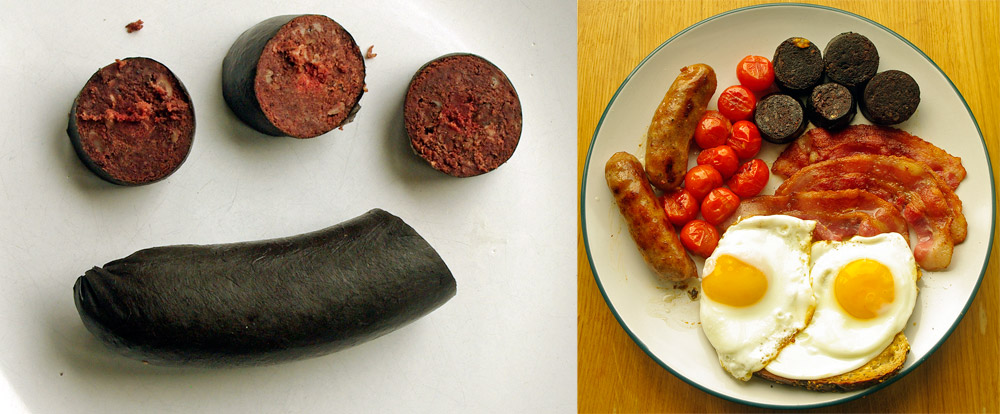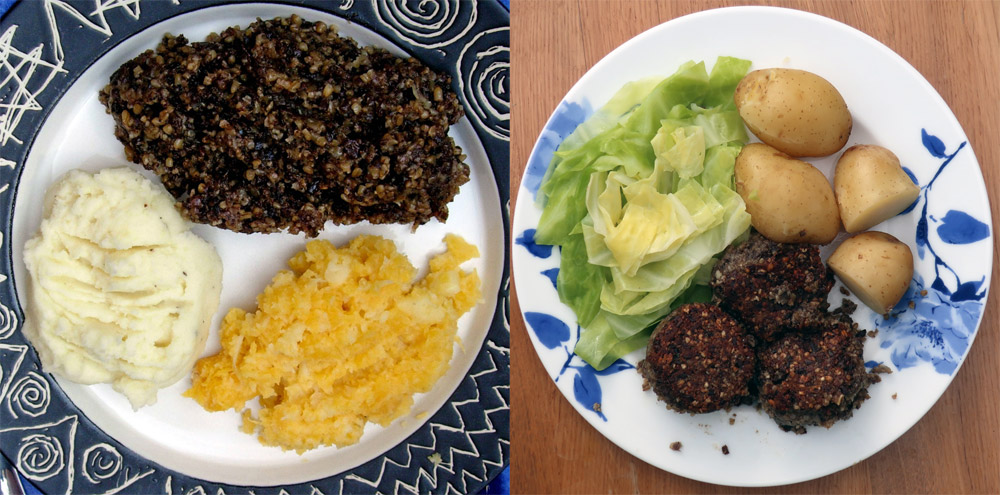With a temperate maritime climate warmed by the gulf stream, long spring and summer days and reliable rain, Britain has the right conditions to grow a range of quality foods.
Food in Britain - Produce
Classic British
dishes here |
Authentic
British Experiences
There is a school of thought that says that the reason Britain didn't historically develop a sophisticated cuisine is that with reliable rain and a not too hot and not too cold climate, the things that grow here grow well, so with high quality produce that speaks for itself there was little need to disguise it so much by fancy cooking.
There has been a big push in recent years towards consuming local foods in Britain, increasing the quality available as shelf-life and resilience to transport become less important factors and you're far more likely to be eating it shortly after it has been picked or made and at its best.
Cheese:
Two British Cheeses - A quality mass market mature cheddar on the left and a blue locally produced cheese on the right. There are over 700 different named cheeses in Britain, going local is far easier than trying to get something from the other end of the country because some celebrity chef recommended it, and probably just as good
There are over 700 named British cheeses produced in the UK and British cheese making could well be at an all time high in variety, quality and the amount of people who appreciate good cheese. In the early 2000's milk production by dairy farmers became financially difficult, not worth continuing in some cases. So many of those dairy farmers who were being pushed to the edge decided to take their already superior product that came courtesy of Britain's rainfall and oh-so-green fields and use it to make cheese instead, as it happens they make it very well indeed.
The result is that good and great cheese is now easy to get in Britain and is world class.
With 700 varieties available many of which are produced on individual farms, sourcing these cheeses can be either very easy if the farm shop is a short walk away or quite difficult if it is at the other end of the country, so rather than recommend an esoteric variety I once tried that you will struggle to get, here are some category suggestions.
Cheddar - A quintessentially English cheese originating in the Somerset village called Cheddar not later than the 12th century and possibly long before. It accounts for about half of all cheese sold in the UK. Cheddar is fairly hard, off-white or pale yellow and comes in mild, medium, mature and vintage varieties. The cheaper mass produced and mild versions are best avoided, supermarkets sell volume produced mature, extra mature and vintage varieties which are good everyday cheeses for all purposes. There are also dozens of cheddar cheeses made by smaller producers each of which has its own particular characteristics, they can vary quite a lot in flavour but are generally at the stronger, or sharper end of the flavour scale (possibly off the scale if you've only ever had mild mass produced cheddar).
Stilton - Another English classic, only cheese made in the counties of Derbyshire, Leicestershire and Nottinghamshire can be called Stilton the name has designated origin status under EU law. The name comes from the Cambridgeshire village where in the 18th century the cheese was put onto stage coaches to be taken to London, though ironically Stilton cheese cannot be made in the village of Stilton. It is a crumbly, creamy, blue cheese with a strong flavour and smell, it can be eaten simply with crackers when it goes very well with port or sweet wines such as Madeira or used in cooking with vegetable soups, in steak sauce, in salads or with a ploughman's lunch.
Stilton is sometimes compared to Roquefort or gorgonzola, though doesn't have the tanginess of those cheeses, it really is a different kind of cheese and you should try it if you haven't already. There is a white version available though it is much less consumed.
There are other blue cheeses in Britain that are well worth trying if you are a fan of the style, Blacksticks blue from Lancashire and Shropshire blue can be widely obtained and of course there are lots of smaller production local specialties.
Wensleydale - A creamy, crumbly white cheese originating from Wensleydale in Yorkshire, first made by monks around 1150, now a style of cheese rather than necessarily being from Wensleydale itself. Originally a blue cheese but now predominantly white, blue versions are still available but far less commonly. As with some other cheese styles mass production has meant that much that is sold as Wensleydale is fairly ordinary, though the best is sublime, price is a useful guide, stay away from the cheap industrial stuff.
Where to get cheese in Britain: Sometimes available as an alternative dessert in restaurants. Most readily in prepared sandwiches though these will have mass produced cheese. Good cheeses can be obtained from supermarkets, delicatessens and cheese shops though the latter aren't aren't so common. It is a great addition to a picnic lunch along with some crusty bread for a quick meal grabbed from a local shop, it is frequently eaten with chutney of some sort which can be found in some variety in supermarkets and any decent place that sells cheese.
I've found British cheese makes a very
welcome gift when going overseas, for
your host or as souvenirs for those who didn't travel
with you. Get a plastic Tupperware-type box and
fill it with a variety of cheeses, keep it in the
fridge until the last possible moment and then bury
it in the centre of your luggage surrounded by clothes
to help keep it cool, unpack as soon as you can
at the other end.
buy cheese
Black Pudding:
Black Pudding - as bought at left and part of a Full English Breakfast at right - A dry sausage that is cooked during manufacture and needs little further cooking before serving. It is intensely savoury, often appears in a fry-up but is also very versatile beyond this.
A thick somewhat crumbly sausage with an intense savoury flavour usually cut into thick slices and fried or grilled, though it has already been cooked during its manufacture. You are most likely to encounter this as part of a Full English breakfast though it will probably be an optional part rather than being served by default. The reason is that black pudding is made using blood amongst other ingredients, the very concept of which can cause an attack of the vapours in those of a delicate disposition.
It is made from oatmeal, fat, onion, spices and pigs blood though by the time it arrives on your plate it simply looks like a very dark sausage. As it is so intense in flavour, a fairly small amount is served, about the equivalent of half an ordinary sausage, it is regarded by many (including me) as a highlight in a fry-up.
If you are familiar with the various intensely savoury sausages that are found across Europe and much of Asia and have tried and enjoyed them, then you will be a fan of black pudding. If you have never encountered or considered anything like this, then give it a go, they really are delicious. Black pudding may also appear as an ingredient in other dishes, it can be added to mashed potato and stuffings and goes particularly well with scallops. It is more popular in the North of England, Scotland and Ireland than in the south, the Northern towns of Barnsley and Bury are particularly well known for making black puddings.
Where to get black
pudding in Britain: A frequent inclusion
in fried breakfasts, can be bought from butchers
or most supermarkets carry it, watch out for the
name "Bury" and get that if you can.
buy black pudding
Haggis:
Haggis Neeps
and Tatties - the traditional dish doesn't
exactly lend itself to fancy presentation - left,
steamed haggis at top, mashed swede or "neeps" bottom
right, mashed potato bottom left
right - fried
haggis with boiled potatoes and steamed cabbage,
just a bit of butter needed on the spuds.
The national dish of Scotland, though the first record of it is from Lancashire, England in 1430. Another somewhat divisive food due to the ingredients of sheep's pluck (heart, liver and lungs) along with oats, fat, onion and spices, traditionally enclosed in a sheep stomach to make a large very round and fat sausage.
Haggis is boiled in its casing which is then cut open to serve, the texture is like moist minced meat, traditionally it is served with "neeps and tatties" mashed potato and mashed swede (not turnips as often thought) each cooked and prepared separately, a dram (small glass) of whisky accompanies the dish.
Thanks to Robert Burns writing his "Address to a Haggis" - "Fair fa' your honest, sonsie face, Great chieftain o' the puddin'-race!" etc. Haggis is often eaten on Burn's Night, the 25th of January at a Burns Supper. It is available year-round at a small number of butchers outside Scotland (often Scottish owned or connected) and more widely within Scotland, it is usually found for sale in January and February widely across the UK and is often a seasonal item in national supermarket chains.
Despite the less than tempting description of the ingredients, haggis is actually quite delicious, if you like meat and the texture of sausages, burgers, mince etc. then you'll like it, my only gripe about haggis is that where I live in England I can only get it for a relatively short period at the start of the year. If you see it in a restaurant as a main course it will almost certainly be served in the traditional way, though it has become quite trendy in some restaurants, especially in Scotland to use haggis as an ingredient in other dishes. It is available at some Scottish chip shops deep fried, some Indian restaurants in Scotland make haggis pakoras and it might turn up in dim-sum, on a pizza, in lasagna or as a slice in a bun as a haggis burger.
Serving haggis boiled with neeps and tatties is to my mind the most boring thin you can do with it, you have three things with a similar texture on the plate, two of which are mashed root veg and not so far apart in flavour either. We have it with new potatoes and steamed green vegetables, rather than boil it, we cut it into thick slices and fry or grill them so you get some crunchy bits on the outside too, haggis is far more versatile and tasty than it might first seem.
Vegetarian haggis is also quite widely available.
Where to get haggis
in Britain: Often only available seasonally
in January and February where it may appear on restaurant
menus, can be bought from butchers or supermarkets,
many but not all carry it, availability is increasing
through the year.
buy haggis
Sausages & Sausage Rolls:
The British are keen on sausages which are mainly of a particular type with little in the way of preservatives and no drying meaning they have a short shelf life and have a texture more like fresh meat rather than being firmer like salami style sausages. They are coarsely ground and quite thick and meaty, usually made with pork though sometimes beef or chicken. There are many different kinds, peppery "Cumberland" sausages are popular though except in Cumberland itself (in the NW of England) they probably won't come from there, "Lincolnshire" sausages are herby and describe another style rather than place of origin. Traditional Cumberland sausages are made into a tight spiral, but are more commonly found as "links" formed by twisting the casings in the usual way of preparing sausages.
You may hear them referred to as "bangers" particularly in relation to bangers and mash, this is a name that was given to cheap sausages bulked out with additives, in particular water which would heat and expand on cooking so bursting the skin with a bang, it caught on as a general nick-name.
Sausages are an essential part of the Full English breakfast, you may well encounter them on your first morning here. Bangers and mash, with mashed potato is another classic often served with onion gravy and possibly green vegetables. They are the "toads" in Toad-in-the-Hole, a baked dish of Yorkshire pudding with sausages. Sausages in various kinds of bread are a popular street food with onions as an accompaniment and a range of sauces such as brown or red, mustard or chili. Thin sausages called chipolatas wrapped in streaky bacon and roasted known as "pigs in blankets" are an essential part of the British Christmas dinner, or they may be served with a roast chicken or turkey dinner at any time of year (if you're lucky). Chips shops usually also sell sausages that may or may not be battered and deep fried.
Sausage rolls are made from sausage meat not in a skin but rolled to the size of a sausage, wrapped in pastry and baked. They are widely available as a hot or cold snack, a hot flakey sausage roll on a cold winters day is a great comfort food.
Vegetarian sausages are also widely available.
Where to get sausage
in Britain: You'll have to try hard to avoid
them!
buy sausages
Pork Pie:
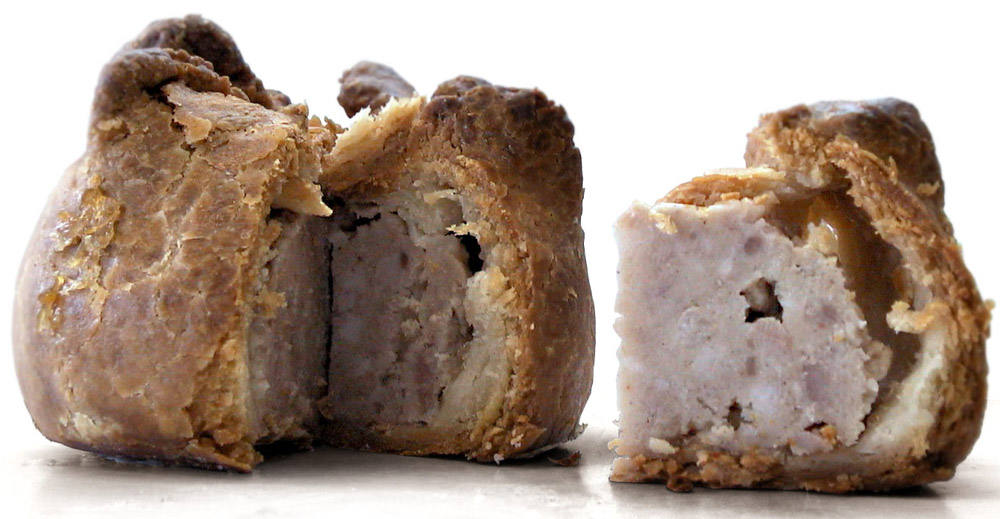
A Pork Pie - This one has been made on a tray, hence the shape, others are made in pie moulds and are much more regular in shape. The size varies a lot from bite size (maybe two bites) to large multi-serving sizes.
A particular kind of meat pie made with a minced pork filling and a firm pie crust, small voids within the pie between crust and meat are often filed with pork jelly. The pies are usually eaten cold as a snack or with other cold meats and salad accompaniments, Chutneys, brown sauce or similar go very well with pork pies, in Yorkshire they may be served heated with mushy peas. Melton Mowbray pork pies have designated origin status under EU law.
Where to get pork pie in Britain: Pub lunches, especially in summer the usual retail outlets including farmers markets and butchers who often make their own.
Scotch Eggs:

Scotch Eggs - A sandard one on the right with pork sausage meat and wrapped in breadcrumbs, on the left the sausage meat includes chorizo and red pepper, black pudding sometimes puts in an appearance.
A hard boiled egg wrapped in sausage meat, dipped in breadcrumbs and either deep fried or baked. The name just seems to have been one that they picked up over the years as there is no particular connection to Scotland. Scotch eggs are sold where many snack and lunch foods are sold, alongside packs of sandwiches and sausage rolls, from supermarkets, garages, corner shops etc. anywhere that might be expected to sell savoury snacks to be eaten on the go, they are usually eaten cold. They make a good addition to salads and cold meats, variations are sometimes found with the wrapping containing black pudding or chorizo, they go well with the usual cold meat accompaniments such as brown sauce and chutneys.
Some restaurants might sell scotch eggs as an eat-in dish in which case they will be freshly prepared, hot and possibly with the egg soft rather than hard boiled with a runny yolk.
Where to get Scotch eggs in Britain: All sorts of snack, lunch and food-on-the-go outlets, not so commonly as part of a meal, maybe part of a lunch salad or buffet.
Yorkshire Pudding:
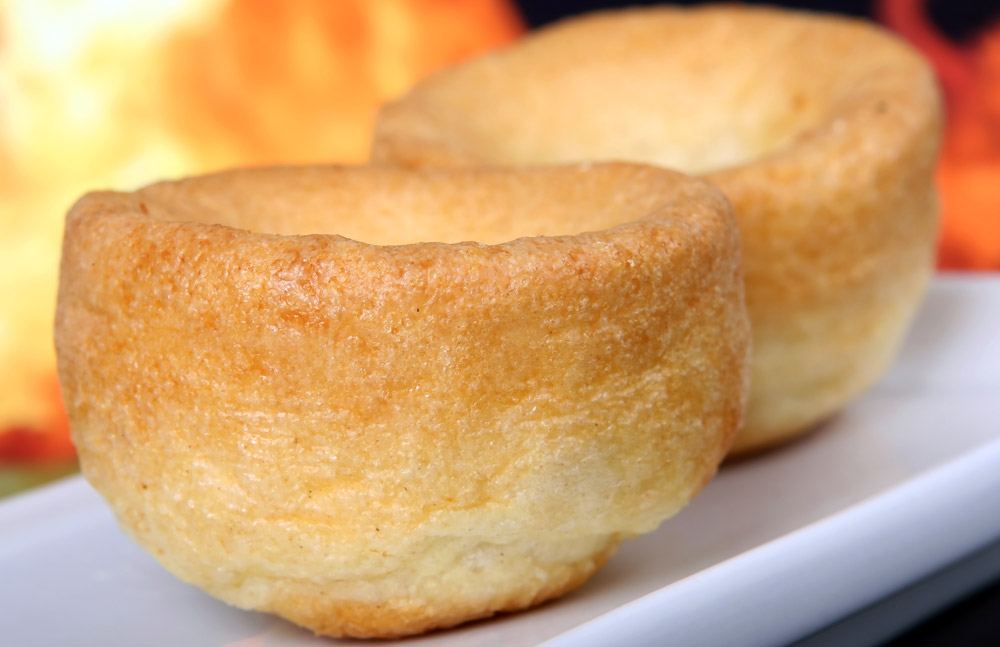
Individual Yorkshire Puddings - These are about 7cm in diameter, two would be served on a plate with a roast dinner, the bowl shape makes them good for holding gravy.
A traditional recipe dating from the 1700's, not unique to Yorkshire or even necessarily invented there, though over time the name stuck. A simple recipe made from batter poured into a thin coating of heated fat in a pan (originally the fat was dripping from roasted meat) and baked in a hot oven so that the puddings rise, a good and impressive rise is considered a mark of a good Yorkshire pudding, they have a outside that is mainly crispy and are fluffy on the inside.
A large roasting pan of any shape may be used and the resulting large pudding cut into individual portions, or small pie or cake tins may be used to produce individual sized puddings. Most commonly Yorkshire puddings (sometimes just called Yorkshires) will be served as part of a roast dinner, especially with beef when they are considered an essential component. As they go especially well with the gravy that comes with roast dinners, they may be served alongside other meats too as well.
Originally they would be used to fill people up as a first course with gravy, so stretching out the more expensive meat, which also happens to some degree when they are served with a main course.
Yorkshire pudding may be served as Toad in the Hole when sausages are dropped into the batter in the pan before cooking. As a child I would sometimes be given a Yorkshire as a dessert with fruit by my very northern grandmother, something she called a "Yorkshire drop pudding", cut rhubarb, plums or blackberries would be dropped into the mix before it went into the oven. If there was no fruit available, I would have it with golden syrup and she would have it with blackberry or raspberry vinegar and sugar.
In more modern times a plate-sized Yorkshire may be used to hold all the other ingredients of a meal in trendy restaurants or even as a flatbread type wrapper for street-food.
Where to get Yorkshire puddings in Britain: As part of a Roast dinner wherever they are sold. If you are self-catering they are simple to cook from raw ingredients or even easier can be bought frozen to heat up in the oven for the last 5minutes cooking time.
Seasonal Fruit:
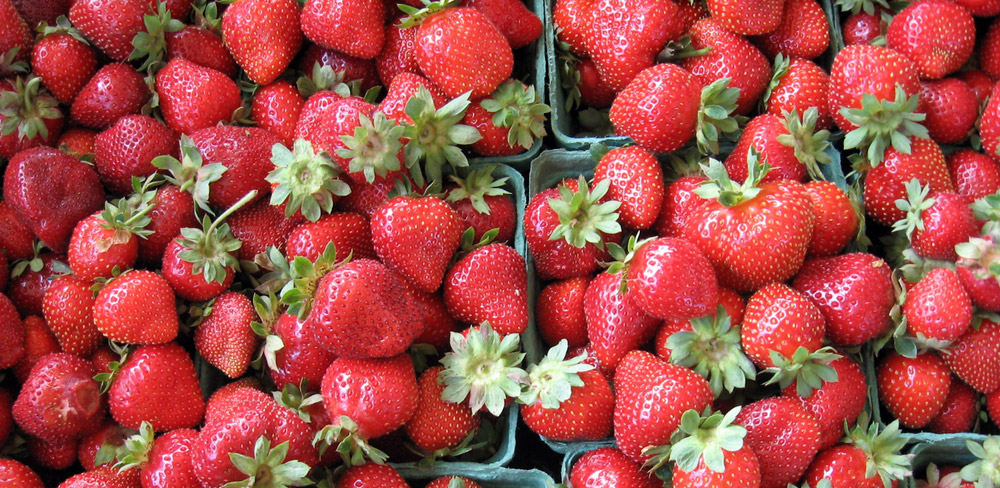
Summer Strawberries for Sale - Locally produced strawberries are a must in the early summer months, best eaten with cream, either simply poured over, or whipped and served with broken meringue, they also go well on top of a jam and clotted cream on a scone.
There are some seasonal delights in late spring and summer you should try if you are here at that time as they are amongst the best examples of their kind in the world.
British strawberries are found everywhere in June and July possibly stretching to August or later, make sure they are British as the imported ones are no-where near as delicious. The traditional way to enjoy them is simply as strawberries and cream which lets the flavour shine through, another simple and favourite way is as "Eton Mess" where the cream is whipped and broken up meringue is added to give extra sweetness and texture.
Apples are another British specialty growing here in greater variety and arguably better quality than any where else in the world, the new crop comes along in late summer and autumn and beats anything that has been artificially held back from maturing in a controlled atmosphere to allow it to be transported thousands of miles. Apples are eaten raw or made into pies and puddings.
At a similar time come Plums which are one of my favourite fruits of all, like apples they grow really well here and in great variety, though the tastiest varieties are delicate and difficult to transport. Apples and plums are best bought from the roadside in areas with orchards, if you have a hire car and are driving around in August or September watch out for stalls at the roadside or in lay-bys, also good places to get British strawberries earlier in the year.
Other berries and currants also grow well in Britain, raspberries and blackberries, and black, white and red currants from mid summer and autumn are delicious additions to puddings and drinks. Wild blackberries can be sampled almost anywhere in the countryside in the season, something I regularly enjoy along with wild plums when walking the dog.
Where to get seasonal Fruit in Britain: Avoid supermarkets other than for strawberries and even then look at the label to make sure they aren't imported. The best seasonal fruit is from the farm or orchard gate if you can get there, there are also often temporary stalls in lay-bys or by the side of the road in rural areas, otherwise markets.
Mince Pies:

Mince pies are one of the early harbingers of the
Christmas season in Britain. If you are here at
that time of year it will be difficult not to be
aware of them, they are a mixture of dried fruits
wrapped in sweet shortcrust pastry and go very well
with a nice cup of tea, what's not to like?
Mince pies are filled with "mincemeat" which contains no meat, instead it has a selection of dried fruits, though did originally have meat (in medieval times) which gave it the name, when the recipe changed the name stuck. It is an essential part of Christmas appearing in the shops in the run up as ready made pies or as jars of mincemeat for people to make their own pies with. Mince pies can be eaten cold or hot when they may served with cream or brandy butter to help avoid weight loss during the holiday season.
Where to get mince pies in Britain: A seasonal treat from about mid-November until Christmas, when they can be difficult to avoid, though again no-one minds if you avoid them as many Brits aren't so keen either. They disappear almost instantly after Christmas Eve.
Picture credits: Haggis, neaps and tatties - courtesy - Juliet Belasyse-Smith and / Pork pie - courtesy - Mark Mordecai / Yorkshire pudding - courtesy - Robert Owen Wahl / Strawberries - courtesy - Alistair Williamson / All picture also courtesy FreeImages


